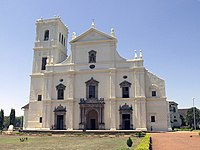History of Goan Catholics
History of Goan Catholics recounts the history of the Goan Catholic community of the Indian state of Goa from their conversion to Christianity to date.
Pre-Portuguese era
No concrete evidence has been found that Christianity prevailed in Goa before the Portuguese arrived, but it is believed that St. Bartholomew, one of the twelve Apostles of Jesus Christ, brought and spread the Gospel in Konkan including Goa, just as St. Thomas had done in Kerala and Tamil Nadu in Southern India.[1]
Portuguese era

In the 15th century, the Portuguese explored the sea route to India and

In 1534, the
Many of the Goan Catholic ancestors of the present
The
The Scottish physician Francis Buchanan visited Canara in 1801. In his book, A Journey from Madras through the Countries of Mysore, Canara and Malabar (1807), he stated that "80,000 Goan Christians came and settled[9] in South Canara at the invitation of the King of Bednore."[10] Later, this was identified as a probable mistake and should have read "8,000". However even this figure included the second emigration of Christians from Goa.[11]
The attacks of the Maratha Empire on Goa, during the mid 17th century, was also a cause of migration. In 1664, Shivaji, the founder of the Maratha empire, attacked Kudal, a town north of Goa, and began his campaign for Goa. After Shivaji's death on 3 April 1680, his son Sambhaji ascended to the throne.[8] The onslaught of Sambhaji, along the northern territories of Goa, drove many Christians from their homelands, and most of them migrated to South Canara. This migration is referred to as the "Third Wave of Migration". During the later years, 1680-1707, the migration slowed because of the Mughal-Maratha wars. Some 10,000 Christians returned to Goa.[8] From the Bardez district of Goa, Jesuit priests estimated that 12,000 Christians migrated to the South of Goa between 1710–1712. A Goa Government report of 1747 recorded that around 5,000 Christians fled to South Canara from the Bardez and Tiswadi districts of Goa during the invasion of the Marathas.[8] It was estimated that during the Maratha raids on Goa, about 60,000 Christians migrated to South Canara.[12]
Modern era
In 1787, inspired by the French Revolution, several Goan Catholic priests, unhappy with the process of promotion within the Church and other discriminatory practices of the Portuguese, organized the Pinto Revolt against the Portuguese. Though it was an unsuccessful revolt, it was the first open revolt against the Portuguese from within Goa. Britain gained control of Goa twice, the first time in 1797–1798 and the second time from 1802–1813. In 1843, the capital was moved to Panjim and by the mid-18th century the area under occupation by the Portuguese expanded to Goa's present day limits. By this time the Portuguese Empire started declining and further resistance to their occupation in Goa started gaining momentum. After the rest of India gained independence in 1947 Portugal refused to relinquish Goa. On 18 December 1961, India moved in with troops and after hostilities that lasted 36 hours, forced the Portuguese administration to surrender. On 30 May 1987, Goa was elevated as India's 25th state.[13]
During the 1970s, coastal communication increased between Bombay and Goa, after introduction of ships by the London-based trade firm Shepherd. These ships facilitated the entry of Goan Catholics to Bombay.[14]
See also
- Catholic Church in India
- Goan Catholics
- Goan Catholics under the British Empire
- History of Goa
Notes
- ^ Ayyappapanicker 1997, p. 263
- ISBN 3-87294-202-6.
- ^ Kerr 1812
- ^ George 1992, p. 205
- ^ Roger Crowley (2015). Conquerors: How Portugal forged the First Global Empire. UK: Faber and Faber.
- ^ Lach 1994, p. 12.
- ^ Silva & Fuchs 1965, p. 4
- ^ ISBN 978-81-86778-25-8. Contents taken from Sarasvati's Childrenarticle, written by Joe Lobo, the President of the Goan Catholic Association in Florida. This article has been borrowed mainly from Alan Machado's above book.
- ^ Buchanan 1988, p. 23
- ^ Buchanan 1988, p. 24
- ^ Silva & Fuchs 1965, p. 5
- ^ Kurzon 2003, p. 77
- ^ Dias 2007, pp. 2–3
- ^ Heras Institute of Indian History and Culture 1983, p. 113
References
- Ayyappapanicker, K. (1997). Medieval Indian Literature: An Anthology. Sahitya Akademi. ISBN 81-260-0365-0. Retrieved 2008-09-20.
- ISBN 81-206-0386-9. Retrieved 2009-03-24.
- Baptista, Elsie Wilhelmina (1967). The East Indians: Catholic Community of Bombay, Salsette and Bassein. Bombay East Indian Association.
- George, K. M. (1992). Modern Indian Literature, an Anthology: An Anthology: Surveys and Poems. Vol. I. Sahitya Akademi. ISBN 978-81-7201-324-0. Retrieved 2008-11-17.
- Dias, Giselle (May 2007). A search for an identity Catholic Goans;– How they fit in a predominantly Hindu India (PDF). Goan Association of Toronto, Canada. Archived from the original (PDF) on 21 November 2008. Retrieved 23 December 2008.
- Heras Institute of Indian History and Culture (1983). Indica. Vol. 20. St. Xavier's College (Bombay).
- Kerr, Robert (1812). "Discoveries, Navigations, and Conquests of the Portuguese in India, from 1505 to 1539". A General History and Collection of Voyages and Travels. Vol. 6. George Ramsay and Company. Retrieved 2008-01-05.
- Kurzon, Dennis (2003). Where East Looks West: Success in English in Goa and on the Konkan Coast. Multilingual Matters. ISBN 1-85359-673-6. Retrieved 2008-12-03.
- Lach, Donald Frederick (1994). Asia in the making of Europe: A century of wonder. The literary arts. The scholarly disciplines. University of Chicago Press. ISBN 978-0-226-46733-7.
- Paul Harding; Bryn Thomas (2003). Lonely Planet: Goa (3rd ed.). Lonely Planet Publications. ISBN 1-74059-139-9. Retrieved 2008-09-17.
- Sen, Surendra Nath (1993). Studies in Indian History:Historical Records at Goa. Asian Educational Services. ISBN 81-206-0773-2. Retrieved 2008-08-24.
- Hunter, William Wilson (2005). The Indian Empire: Its People, History, and Products. Asian Educational Services. ISBN 81-206-1581-6. Retrieved 2008-08-29.
- Silva, Severine; PDF, 2.48 MB) on 2012-02-22. Retrieved 2008-07-08.
- South Kanara District Gazetteer- People (PDF). Karnataka State Gazetteer. Vol. 12. Gazetteer Department (PDF, 2.57 MB) on 2009-03-25. Retrieved 2008-10-26.
